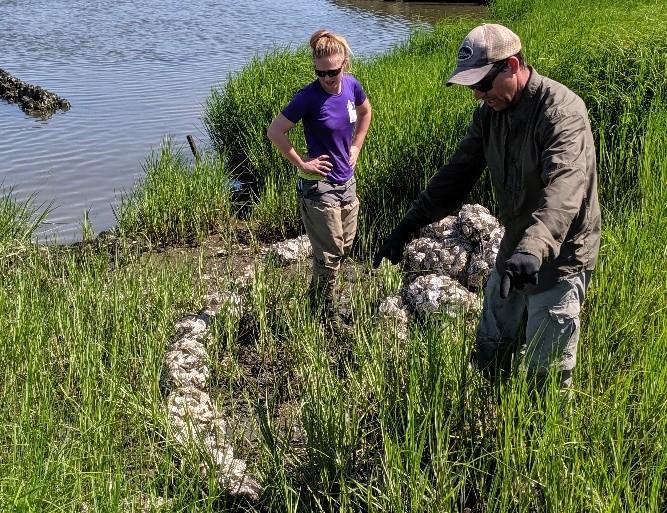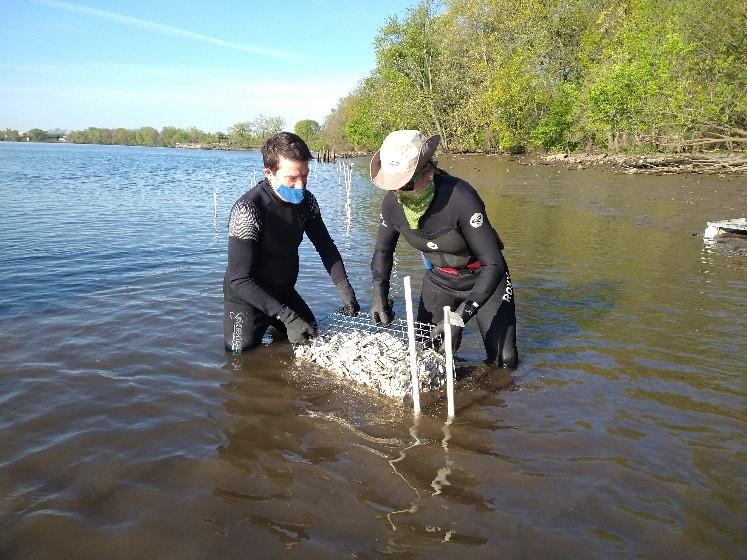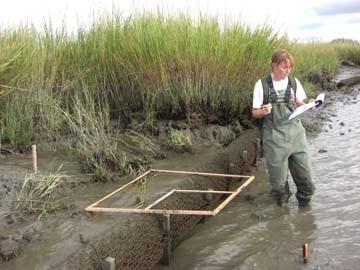
8 minute read
Living Shorelines
from Living Shorelines
Above: PDE Habitats Project Coordinator Sarah Bouboulis, front, and a living shorelines crew from PDE, The Delaware Department of Natural Resources and Environmental Control, and the U.S. Fish and Wildlife Service show off their work adding 180 feet to living shoreline in Lewes, Delaware.
Living Shorelines: Taking Root in the Field of Shoreline Preservation
At high tide on the Lewes Canal in Delaware, it’s hard to see 1,300 bags of oyster shells. You can’t see how fish and crabs feed on the shells, or how they provide a foundation for oyster habitat. What you do see is tall, green, native grasses and water. You may not realize it, but what you’re looking at is a living shoreline, an engineered, nature based, method of protecting acres of precious shoreline from erosion. In August, Partnership for the Delaware Estuary (PDE) gathered at the banks of the Canal with the Delaware Department of Natural Resources (DNREC), U.S. Fish and Wildlife Service, the DNREC Wetland Monitoring and Assessment Program, the City of Lewes, and the Lewes Historical Society on the banks of the Canal to celebrate this living shoreline and a recent 180-foot addition. PDE and DNREC installed the addition in June. The original part of the site was built in 2014. The Lewes living shorelines site is one of 10 projects PDE has throughout Delaware, New Jersey, and Pennsylvania, all built with various partners. It has three more projects in different stages of planning. Since its first project in 2006, PDE’s Delaware Estuary Living Shoreline Initiative (DELSI) has taken root and become an example of shoreline preservation, erosion control, and a method of bolstering cleaner water and healthier plant and animal communities.
“They’re a perfect example of the green tech movement,” said PDE’s Science Director Danielle Kreeger, Ph.D., in reference to living shoreline tactics.
Living shorelines are made of natural materials, such as plants, bivalve shellfish, stone, sand, wood and other organic materials to mitigate erosion and preserve shoreline. The concept was invented by Orrin H. Pilke, Professor Emeritus of Earth and Ocean Sciences at Duke University. Due to sea level rise, brought on by climate change, the Delaware Estuary and Delaware River Watershed is drowning because it’s losing about an acre of tidal marsh every day to erosion. Living shorelines are alternatives to traditional “hard armor” shoreline reinforcements like bulkheads and seawalls.
The hard structures, made of wood and concrete, cut the shoreline off from the surrounding natural habitat. Living systems can build themselves up to keep pace with rising seas, whereas the hard structures cannot. “While conventional methods might hold the shoreline in place, they don’t provide the benefits that a natural habitat does,” said David Bushek, Ph.D., and director of the Haskin Shellfish Laboratory. “By bringing life to that hardened structure, or replacing that hardened structure with a natural structure, we can retain all those habitat functions, and that’s the idea of having a living shoreline as opposed to one that’s sterile or dead.”
INNOVATION AND ECOLOGICAL UPLIFT
Every shoreline site is unique. Therefore, living shorelines need to be tailor-designed, differing from site to site in building materials and technique. PDE mostly uses native plants, like Spartina (marsh grass), and shellfish as its main building blocks. Shellfish, such as oysters and mussels, either cement or bind themselves together and to surfaces, thus reinforcing the shoreline, guarding against wave force, and creating 3-D complexity that provides habitat for other animals like fish and crabs. Since these bivalves are voracious filter-feeders, they can also promote cleaner water in the surrounding area. “Living shorelines are not a singular technique, it’s a suite of technologies that is about ecological goals — it’s about ecological uplift,” said Joshua Moody, Ph.D., Restoration Programs Manager at PDE.
Bushek and Kreeger, longtime friends and colleagues, were able to get the first DELSI site built after they co-wrote a grant application that was funded. “We had mutual interest in this living shoreline approach and wondered if we could do something like that,” Kreeger said. “We were seeing these projects spring up in the southeast, like in the Carolinas with oysters. But the same approach wouldn’t work here because oysters live too low in the tidal zone, and so our idea was to add in ribbed mussels that bind with marsh grass up higher.” With each successful project, the DELSI program grows, and so does PDE’s desire to test the limits of this green technology. PDE has a new project in development in Philadelphia — a living shoreline in a tidal freshwater area of the Schuylkill River. For the first time, PDE will incorporate freshwater mussels, submerged plants, and freshwater wetland plants. The project has similar shoreline protection, habitat creation, and water filtration goals as saltwater projects, but this project will additionally “green up” a dilapidated shoreline in a community that has long suffered from environmental injustice. “There’s a much broader cast of characters in freshwater tidal systems — much greater plant and animal diversity,” Kreeger said. “No one has ever done a freshwater tidal living shoreline to our knowledge. That’s what makes this exciting for us. If the project is successful, it should open up new opportunities to expand our limited restoration toolkit in urban landscapes.”

Like living laboratories, each of PDE’s living shoreline projects offers ecological research and learning opportunities. “Everything that we’ve done from day one until today is set up to learn what works and what doesn’t work,” Kreeger said. “If you’re not seeing some failure, then you’re not learning. You have to figure out what the tolerance limits are for certain things that you’re testing. And the only way to do that is to do that is to put things in some crazy places and have a really good scientifically-based monitoring program and see it through.” Moody said this emphasis on research and monitoring is what sets PDE’s living shorelines program apart from many others in the country. “Although some entities focus on large-scale protection efforts, we have found our niche in the science of innovation and research,” Moody said.

COST AND VALUE
The value of monitoring is not just to help learn from research studies — it can also be necessary to ensure a project’s succeeds. Living shorelines, unlike traditional methods, are not projects that you build once and forget about. They need regular monitoring. “They’re like gardens that you need to tend,” Kreeger said. “I think this presents a new and different type of business opportunity whereby companies might develop service contracts to maintain a living shoreline, much like a landscaping and gardening contract, rather than a traditional construction contract.” Justifying the cost of something that will need years of monitoring and maintenance may seem like an uphill battle, but the up front installation costs can be lower and the path is getting easier. It used to be difficult in some places to get the necessary permits to build a living shoreline, whereas seawall and bulkhead permits were easy to acquire. Now, Delaware and New Jersey, Moody said, are taking more progressive approaches to shoreline protection and value projects that provide ecological enhancement.
“Where we are now is at the cusp of a paradigm shift,” Kreeger said. “In addition to the direct cost comparison between living shorelines and traditional projects, we’re entering an age where the indirect ecological benefits will increasingly be valued.”
“What is the value of clean water? What is the value of carbon capture? What is the value of fish and wildlife that are produced in these fringing marsh habitats? Economies are going to be evolving around these green technologies, so once you start to capture the ecosystem benefits that these kinds of projects have over a traditional bulkhead or seawall, then I think that return on investment is going to start tilting heavily toward the more green approaches, and this is true for everything with ecological restoration.”
The Army Corps of Engineers now lists dunes and living shorelines as tactics for shoreline stabilization because they provide comparable or better outcomes than hard-armor approaches. Bushek said that the military recognizes this technology for protecting coastal operations. “When the Army Corps of Engineers recognizes the value of this tactic, it’s a big game changer,” Kreeger said.

This year, as PDE celebrates its 25th anniversary, the organization is not only reflecting on its accomplishments, but casting an eye to the future. PDE’s living shorelines program has secured its place there. “We have established a firm reputation of being interested in doing meaningful, well-respected work, and I think that regional partners absolutely see an important place for us in moving forward with living shorelines and nature based infrastructure,” Moody said. From a small project in the Delaware River Watershed, the DELSI program has become an example of what national estuary programs can do.
“We’ve evolved light years in 15 years by going from an idea to an actualized program that extends well beyond PDE,” Kreeger said. “This is thanks to similar-minded, hard-working partners, visionary funders, and tireless, passionate staff.”
SEE OUR LIVING SHORELINES STORY MAP: https://bit.ly/3kmgn9n
THIS ARTICLE RELATES TO THE DELAWARE ESTUARY COMPREHENSIVE CONSERVATION MANAGEMENT PLAN VIA HEALTHY HABITATS • GOAL H1.3

